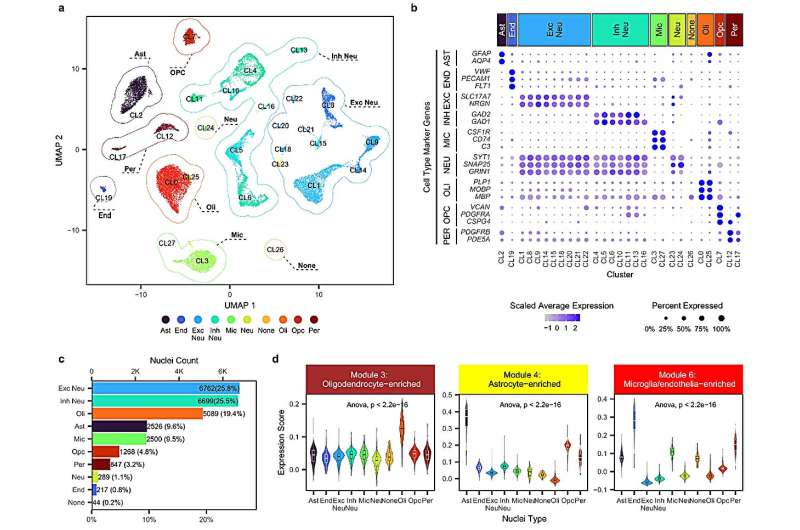This article has been reviewed according to Science X's editorial process and policies. Editors have highlighted the following attributes while ensuring the content's credibility:
fact-checked
peer-reviewed publication
trusted source
proofread
Researchers discover new molecular drug targets for progressive neurological disorder

There is no cure for progressive supranuclear palsy (PSP), a brain disorder marked by walking and balance difficulties. Its symptoms also mimic Parkinson's disease and dementia. The condition leads to rapid, progressive decline and death.
In a new paper published in Nature Communications, Mayo researchers and collaborators outline new therapeutic targets that may lead to potential future treatments for PSP, as well as Alzheimer's disease and related disorders.
People with PSP usually are diagnosed in their late 60s and 70s. While the cause isn't known, researchers have found that the deteriorating brain cells of people with PSP have excess amounts of a protein called tau. Clumps of tau are also found in people with other neurodegenerative disorders, such as Alzheimer's disease.
In this study, the researchers zeroed in on RNA, the carrier of genetic information in all living cells. They integrated brain RNA data from two large, independent human study groups, including donor samples from patients with PSP from the Mayo Clinic Brain Bank. They performed RNA sequencing, which allowed them to discover which genes in certain brain cells were abnormally high or low in patients with PSP.
Each study group contained brain samples from people who had died from PSP, as well as a control group of brain samples from people who did not die from a neurodegenerative disorder. The researchers used samples from more than 400 people overall.
After performing the RNA sequencing, the researchers used a computational model to systematically identify nearly 5,000 genes involved in PSP in relevant brain cells. They then compared their findings to an analysis performed in a preclinical model that mimics the brain pathology seen in PSP. In the end, the researchers "ranked," or prioritized, 11 high-confidence genes that are unusually elevated in human PSP brains and this model.
Finally, the investigators manipulated these target genes in an experimental fruit fly model. They wanted to determine whether reducing the levels of these abnormally elevated genes could correct the degeneration in the model. Among the 11 high-confidence genes, researchers found that reducing the levels of DDR2, KANK2 and STOM showed the most promise in reversing disease and as leading targets for therapeutic development.
"This research enhances our understanding of progressive supranuclear palsy and other related incurable neurological disorders," says the study's senior author, Nilüfer Ertekin-Taner, M.D., Ph.D., a Mayo Clinic neurologist, neuroscientist and chair of the Department of Neuroscience. "Moving forward, we can target these specific genes or others that are biologically related to them to develop a potential treatment for this untreatable disease."
The team also built a web application to enable data-sharing among the wider research community.
"This project highlights the power of multiomics data," says Yuhao (Harry) Min, a Mayo Clinic Graduate School of Biomedical Sciences predoctoral student in the Clinical and Translational Science track and first author of the paper. "Using these datasets, we were able to tease apart the complex molecular changes that took place in patients with PSP, which is important to understand to find a cure for this disorder.
"We also shared our datasets with the scientific community to enable collaborative efforts, with the goal of finding a treatment for patients. Because PSP shares similar biology as other neurological disorders such as Alzheimer's disease, we hope our findings might also benefit drug discovery efforts in other neurological disorders."
The next steps in this research are to work on the synthesis of small nucleic acid molecules that can regulate the target genes identified in this study. The researchers hope to assess the safety and efficacy of those molecules in cell and animal models, with the long-term goal of beginning clinical trials in PSP patients.
More information: Yuhao Min et al, Cross species systems biology discovers glial DDR2, STOM, and KANK2 as therapeutic targets in progressive supranuclear palsy, Nature Communications (2023). DOI: 10.1038/s41467-023-42626-3



















